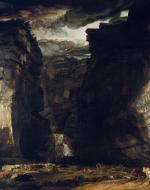Created by Chelsea Brian on Thu, 12/02/2021 - 00:35
Description:
James Ward (1769-1859)
Gordale Scar (A View of Gordale, in the Manor of East Malham in Craven, Yorkshire, the Property of Lord Ribblesdale) c. 1812-1814, exhibited 1815
Tate Collection
This painting was composed by James Ward sometime between 1812 and 1814, and is made up of oil paint on canvas. It was exhibited in 1815, so had received acclaim well within the artist’s lifetime. The composition depicts a scene of towering limestone cliffs near Settle, Yorkshire, as well as an assortment of cattle resting and grazing at the base of the cliffs. The painting was commissioned by Lord Ribblesdale, who was the landowner of the depicted scene. The soaring cliffs that dominate the piece, as well as the turbulent clouds above, exemplify the concept of the sublime that was widespread during the Romantic Era. The composition gives a strong impression of nature overpowering the diminutive viewer that makes up the painting’s perspective, thus offering a prime illustration of the sublime’s terrifying, yet awe-inspiring aesthetic qualities. However, the curated view of the scene is also an example of the picturesque in its rugged and irregular appearance and bucolic aesthetic. It was commonplace at this time for landowners to request artistic depictions of their estates, and this is an apt example of this practice, particularly as relating to its carefully composed, and likely exaggerated, appearance. James Ward was well-known for his masterful paintings of animals, so was especially suited for this pastoral, yet sublime, piece of art that encapsulates several aesthetic concepts of the Romantic Era.
Keywords: sublime – picturesque – nature – curation – class
Copyright:
Associated Place(s)
Part of Group:
Featured in Exhibit:
Artist:
- James Ward


